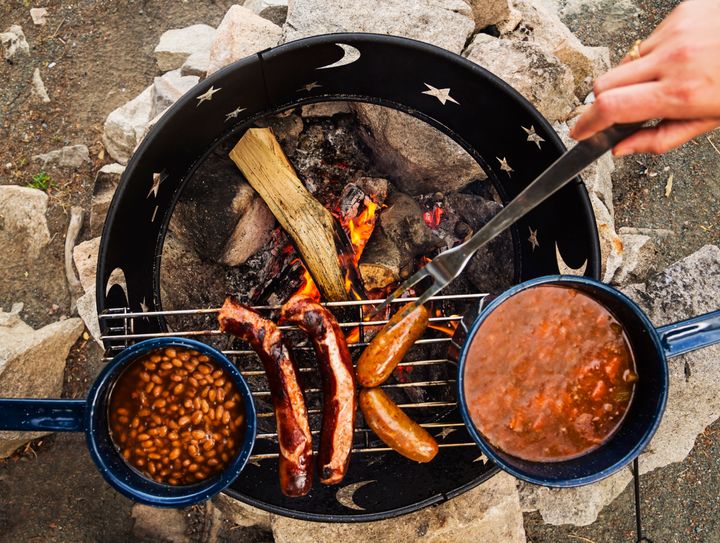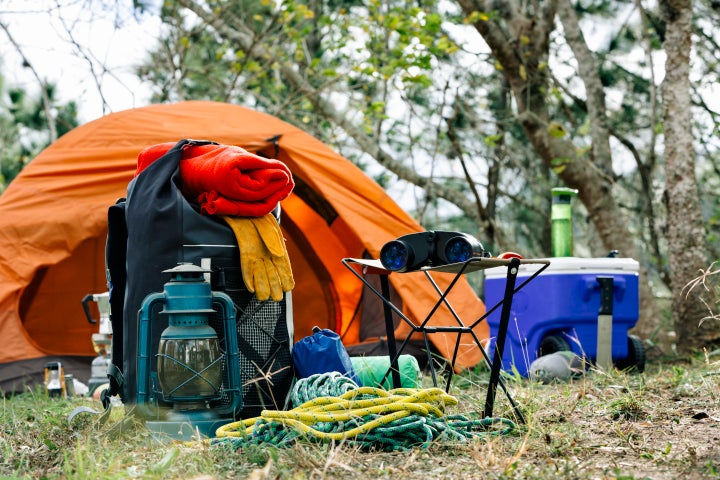
You’re heading out on a camping trip for the weekend and everything is good to go. Your tent, sleeping bags and camping mats are neatly packed in your boot alongside your camping chairs.
You’ve triple-checked the tent poles are in the bag where they’re supposed to be. You have more than enough mosquito spray. Then you remember one key detail you somehow missed: food.
Anyone who’s ever gone camping knows the question of what food to pack is simultaneously one of the most exciting and daunting aspects of the whole adventure.
Yes, camping meals can be delicious and fun to prepare. But figuring out what to bring can also be extremely stressful and raise a lot of questions, like do eggs really need to be refrigerated? Will those jars of peanut butter and jam be OK sitting in the car for a few days?
We reached out to food safety experts to learn more about which foods are both delicious and food safe while camping. Here’s what they recommend:
Nuts and dried fruit
There’s a reason campers and hikers are always chomping on trail mix – it’s shelf stable and doesn’t require refrigeration.
“These are good options to put into airtight containers, stored in your backpack or picnic basket,” said Tamika Sims, the senior director of food technology communications at the International Food Information Council.
Crackers and granola
Like nuts and dried fruit, shelf-stable, non-perishable foods like crackers, cookies, granola and uncooked pasta and rice are good options when camping. Powdered pancake mix is a good item to bring along for breakfast.
If you’ll be camping in weather that’s over 80 degrees Fahrenheit for more than a couple of hours, an ice pack can help maintain the texture and taste of these shelf-stable foods, Sims said.
Check out our tips for how to pack a cooler that’ll stay cold.
Tinned fish, meat and soup
Tuna and other tinned fish or meat products don’t require refrigeration, making them good camping food options. The same goes for tinned soup.
“These foods have a long shelf-life, and you do not have to worry about their temperature,” said Kimberly Baker, a registered dietician and food systems and safety program team director at Clemson University.
“Many of these also require little preparation at the campsite or just adding water and heat before eating.”
Oranges
Oranges and other fresh fruit that normally sit out in the produce aisle are another solid choice. They don’t require refrigeration and often have a thick peel for protection, Sims explained.
Another perk of packing fruits like oranges, bananas and tangerines is that they don’t require additional washing once peeled, as long as your hands are clean.
Keep in mind that if the peel is broken, the fruit is more susceptible to bacteria growth, Sims said.
Tinned fruit
Tinned peaches, fruit salad and other canned fruit products are a great option to eat while camping, especially if you finish the whole can in one sitting so that no refrigeration is required, Sims said.
Just don’t forget your can opener if it doesn’t have a pop-top!
Dehydrated and freeze-dried meals
Dehydrated foods designed for backpacking are some of the best foods to take camping, said Don Schaffner, an extension specialist in food science and distinguished professor at Rutgers University.
These meals are among the easiest foods to bring camping or hiking because they are lightweight, don’t require any refrigeration, and are simple to prepare.
Typically, all you need to do is boil some water, add it to the package, stir everything together, seal the pouch and wait a few minutes (usually less than 10 minutes) before your meal is good to go.
Some people also dehydrate their own food to take camping and backpacking, but that requires a food dehydrator and is a bit more complex.
Peanut butter
“Peanut butter is absolutely safe to keep unrefrigerated whether it has been opened or not,” Schaffner said. “If you have the natural kind of peanut butter that separates, often you’ll keep this refrigerated at home to stop the separation process ― but there is nothing risky about this food if it’s unrefrigerated and the oil separates.”
If you’re thinking of making peanut butter and jelly, know that jelly and jam are safe to keep unrefrigerated before the jar has been opened. But once the jar is open, you’ll need to refrigerate it to prevent mould growth.
“If you choose to keep these unrefrigerated after opening, they are safe to use as long as you do not see any visible mould,” Schaffner said. “If you see a visible mould, the jam or jelly should be discarded.”

Hard-boiled eggs
If you want to bring eggs camping, Schaffner suggests making hard-boiled eggs at home and allowing them to cool at room temperature out in the air.
“This will result in a shelf-stable product that has minimal food safety risk,” he said. He explained that air cooling prevents the possible infiltration of any organisms into the eggs that could happen if you cooled them in water.
They should remain shelf stable for several days.
“Be sure that the shells are not cracked and not to cross-contaminate the eggs after cooking because they are porous,” said Ellen Shumaker, a food safety expert and director of outreach for the Safe Plates program at North Carolina State University.
But the same doesn’t go for raw, uncooked eggs. Unfortunately, you can’t just leave those out unrefrigerated — they must be kept in a cooler. “If raw eggs are taken camping to be cooked later, they should be kept 41 degrees Fahrenheit or below,” Shumaker said.
Schaffner doesn’t recommend bringing uncooked eggs at all. Coolers can be unreliable, he explained. If you’re going camping for an extended period of time, it’s hard to control the temperature of your cooler and you may not be able to restock your ice.
A few extra tips to keep in mind
Keep refrigerated items cold
“If bringing food that requires refrigeration, make sure they are packed in an airtight insulated cooler with enough ice packs to keep the food cold — below 40 degrees Fahrenheit — for the duration of the trip,” Baker said.
If you can’t keep these foods cold for the whole duration of your trip, make sure to use them at the beginning of the trip when they can be kept cold. “Perishable food not kept cold can cause a foodborne illness if consumed,” Baker added.
Frozen water bottles can work like an ice pack
“A great tip is freezing water bottles ahead of time and using them as ice in the cooler — when they melt, you have ice-cold water,” Sims said.
Use a thermometer to check your cooler’s temperature
If you’re keeping any food in the cooler, make sure to check the temperature frequently to make sure it’s cold enough.
“If food is sitting out in the temperature danger zone ― between 40 and 140 degrees F ― for more than two hours at your picnic or camping site, throw it away,” Sims said.